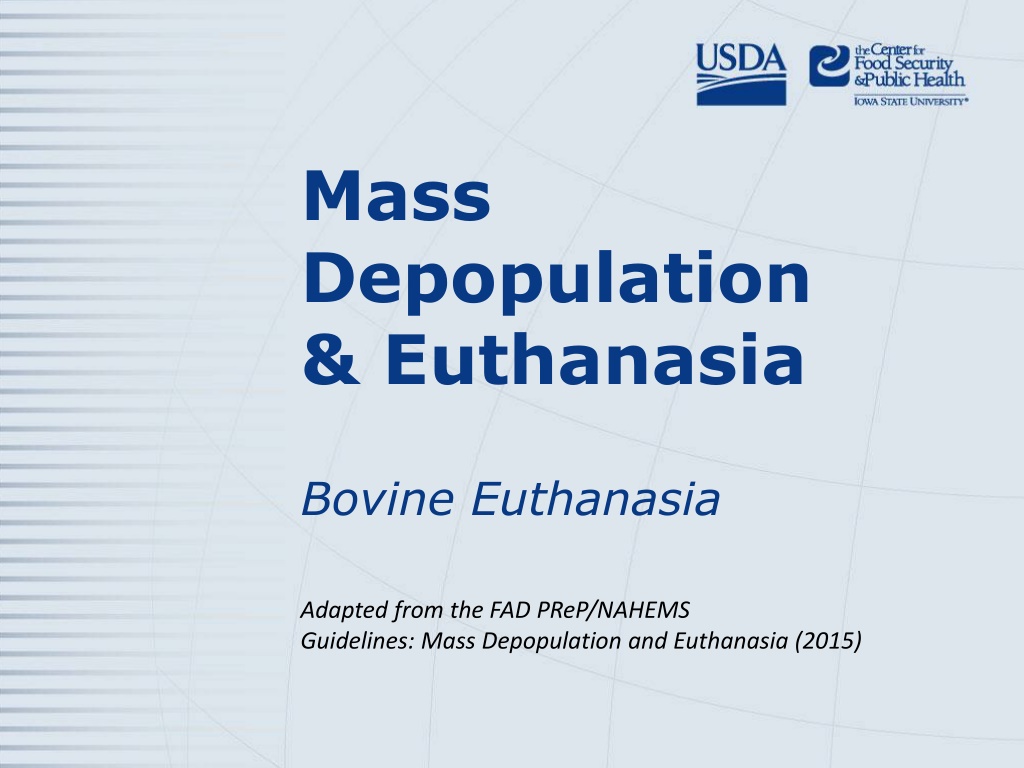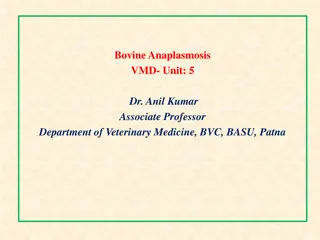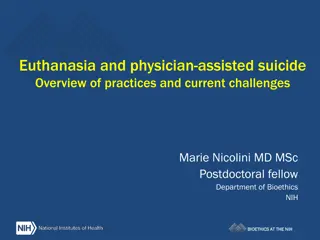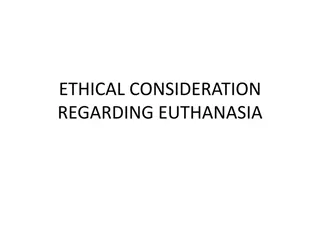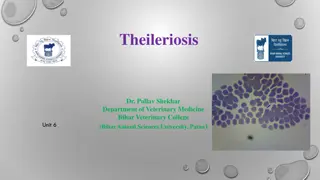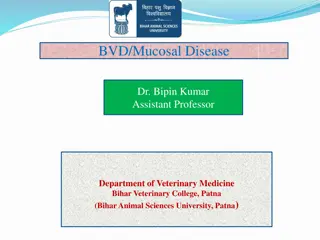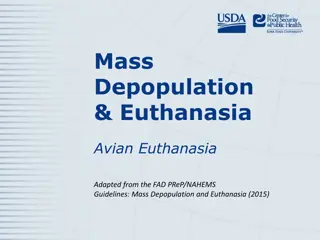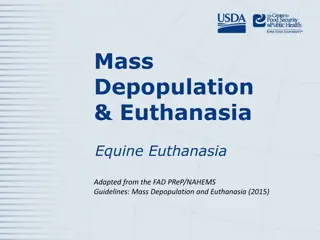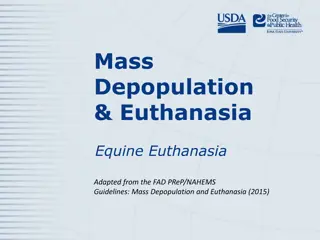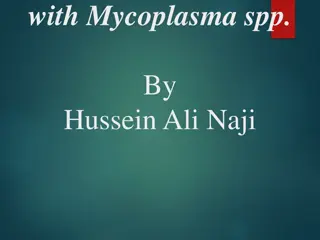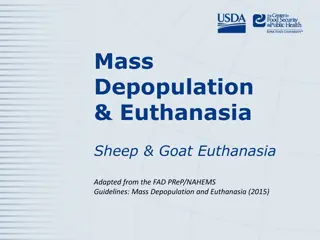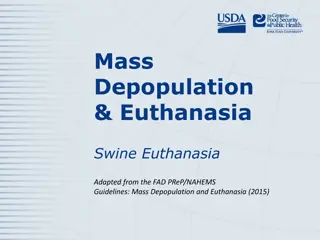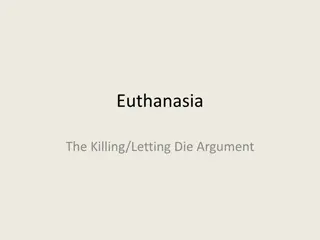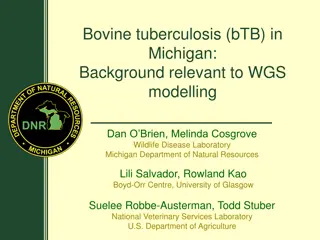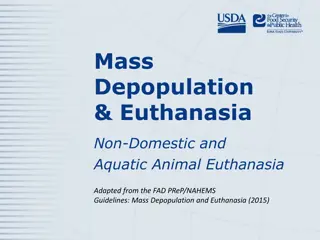Understanding Bovine Euthanasia and Mass Depopulation Guidelines
Exploring the guidelines for bovine euthanasia and mass depopulation, focusing on humane transitioning, handling procedures, acceptable euthanasia methods, and considerations during an animal health emergency. The information covers aspects such as minimizing stress, selecting appropriate methods, and upholding welfare standards to ensure a smooth and respectful process during these challenging situations.
Download Presentation

Please find below an Image/Link to download the presentation.
The content on the website is provided AS IS for your information and personal use only. It may not be sold, licensed, or shared on other websites without obtaining consent from the author. Download presentation by click this link. If you encounter any issues during the download, it is possible that the publisher has removed the file from their server.
E N D
Presentation Transcript
Mass Depopulation & Euthanasia Bovine Euthanasia Adapted from the FAD PReP/NAHEMS Guidelines: Mass Depopulation and Euthanasia (2015)
Euthanasia and Depopulation Euthanasia Transitioning painlessly and stress-free as possible Mass Depopulation Large numbers, quickly and efficiently Consideration to welfare as practicable Terms used interchangeably here FAD PReP/NAHEMS Guidelines: MDE-Bovine USDA APHIS and CFSPH
Euthanasia and Depopulation May be practiced during an animal health emergency Goals of Euthanasia Provide humane treatment Select acceptable method Minimize negative emotional impact Safeguard food chain Prevent or mitigate disease spread FAD PReP/NAHEMS Guidelines: MDE-Bovine USDA APHIS and CFSPH
Handling Goal: Humane Treatment Decrease animal stress, excitement Do not force animals to travel quickly Avoid electric prods Human body position Flight zones Flags Plastic paddles Handle animals quietly FAD PReP/NAHEMS Guidelines: MDE-Bovine USDA APHIS and CFSPH
Euthanasia Methods Acceptable (noninhalant injectable) Barbiturates Barbiturate derivatives Conditionally Acceptable (physical) Penetrating captive bolt Gunshot Electrocution FAD PReP/NAHEMS Guidelines: MDE-Bovine USDA APHIS and CFSPH
Noninhalant Injectable Usually impractical Slow process Expensive Carcass disposal Recordkeeping May be used if animal is considered to be pet/companion FAD PReP/NAHEMS Guidelines: MDE-Bovine USDA APHIS and CFSPH
Physical- Captive Bolt Fatal blow in one procedure Use appropriate restraint Have adjunct measure available Bolt positions Horned animal Developed horned base Polled animal FAD PReP/NAHEMS Guidelines: MDE-Bovine USDA APHIS and CFSPH
Physical- Gunshot Conditionally acceptable Species-appropriate ammunition, appropriate caliber weapon Proper training, skills, experience Close range, same point of entry as captive bolt Muzzle 2-10 inches from entry point In older animals, avoid midline Move aiming point 1 inch to either side FAD PReP/NAHEMS Guidelines: MDE-Bovine USDA APHIS and CFSPH
Physical- Gunshot (contd) Gunshot at long range generally unacceptable If necessary Aim between eye and base of ear Do not target chest or neck region Safety reminder! FAD PReP/NAHEMS Guidelines: MDE-Bovine USDA APHIS and CFSPH
Electrocution Not practical field method for bovines Animal handling is difficult If used: Tranquilize or sedate first Electric current through brain to stun Ear to ear, poll to muzzle Electric current through heart Sides of animal over heart FAD PReP/NAHEMS Guidelines: MDE-Bovine USDA APHIS and CFSPH
Adjunct Methods Second shot IV potassium chloride or magnesium sulfate Pithing Exsanguination FAD PReP/NAHEMS Guidelines: MDE-Bovine USDA APHIS and CFSPH
Confirmation of Death Confirmation of death can be difficult Sustained lack of heartbeat and respiration Rigor mortis Evaluate by competent, experienced personnel FAD PReP/NAHEMS Guidelines: MDE-Bovine USDA APHIS and CFSPH
For More Information FAD PReP/NAHEMS Guidelines: Mass Depopulation and Euthanasia (MDE) (2015) http://www.aphis.usda.gov/fadprep MDE web-based training module http://naherc.sws.iastate.edu/ FAD PReP/NAHEMS Guidelines: MDE-Bovine USDA APHIS and CFSPH
Guidelines Content Authors (CFSPH): Rene Dewell DVM,MS Nichollette Rider, Veterinary Student Significant contributions to the content were provided by USDA APHIS VS: Lori P. Miller, PE Darrel K. Styles, DVM, PhD FAD PReP/NAHEMS Guidelines: MDE-Bovine USDA APHIS and CFSPH
Acknowledgments Development of this presentation was by the Center for Food Security and Public Health at Iowa State University through funding from the USDA APHIS Veterinary Services PPT Authors: Dawn Bailey, BS; Kerry Leedom Larson, DVM, MPH, PhD, DACVPM Reviewers: Glenda Dvorak, DVM, MPH, DACVPM: Cheryl L. Eia, JD, DVM, MPH, Patricia Futoma, BS, Veterinary Student, Rene Dewell DVM,MS
